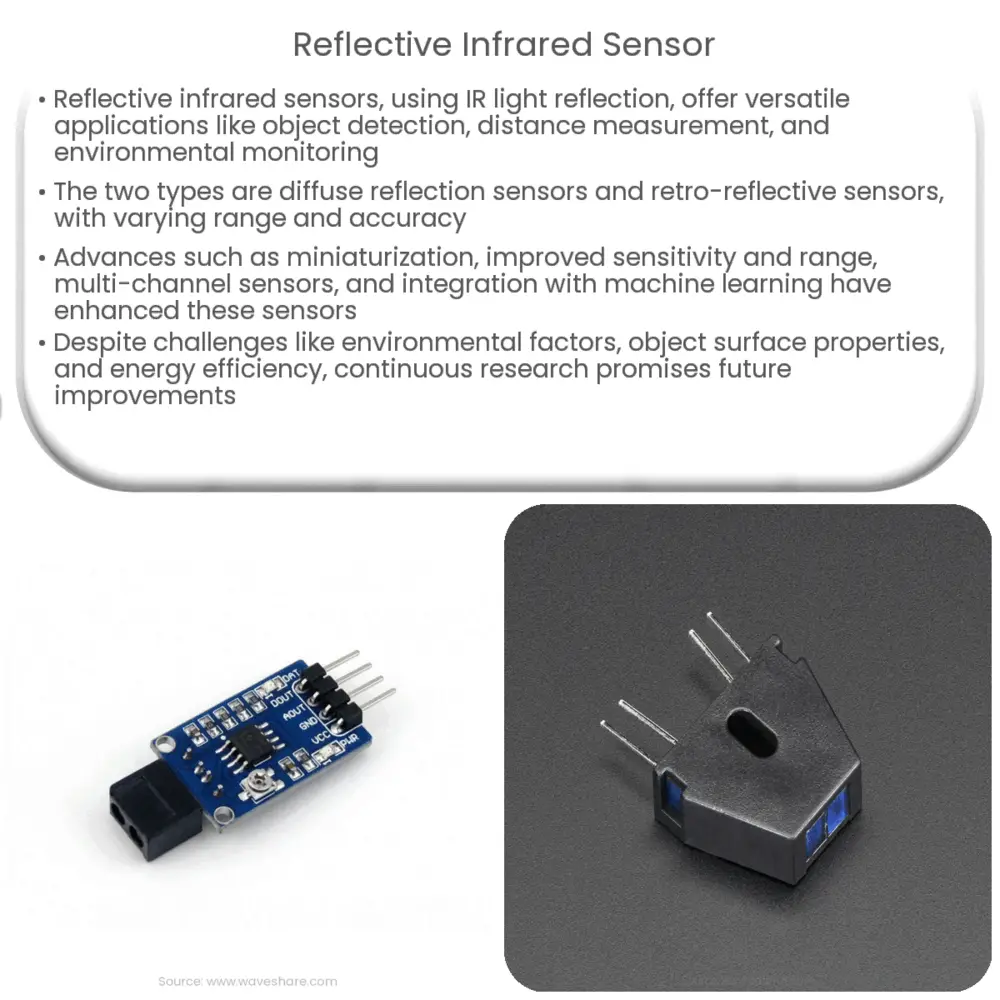Reflective infrared sensors detect objects & measure distances using emitted IR light and its reflection, with applications in automation, robotics, and environmental monitoring.

Reflective Infrared Sensors: Principles, Applications, and Advancements
Introduction
Reflective infrared sensors are versatile and widely used devices for detecting objects, measuring distances, and monitoring environmental conditions. These sensors rely on the principle of infrared (IR) light reflection to provide reliable and accurate information about the presence and position of objects. In this article, we will explore the working principles of reflective infrared sensors, their applications, and recent advancements in the technology.
Working Principle of Reflective Infrared Sensors
Reflective infrared sensors are based on the principle of emitting infrared light and detecting the reflected light from the target object. The sensor consists of two main components: an infrared emitter, typically an infrared LED, and an infrared detector, usually a photodiode or a phototransistor.
When the infrared emitter emits IR light towards an object, some of the light is reflected back towards the sensor, depending on the object’s surface properties and distance from the sensor. The infrared detector receives the reflected light and converts it into an electrical signal proportional to the intensity of the received light. This electrical signal is then processed by the sensor’s circuitry, which can be used to determine the presence or absence of an object, its distance, or other relevant information.
Types of Reflective Infrared Sensors
Reflective infrared sensors can be classified into two categories based on their working principles: diffuse reflection and retro-reflective sensors.
Diffuse Reflection Sensors
Diffuse reflection sensors rely on the object’s surface properties to reflect the emitted infrared light back to the sensor. The amount of reflected light depends on the color, texture, and material of the object’s surface. Diffuse reflection sensors are suitable for detecting objects with varying surface properties and shapes, but they might have limited sensing range and accuracy due to the dependency on the object’s surface properties.
Retro-Reflective Sensors
Retro-reflective sensors, on the other hand, use a special reflector or reflective tape placed opposite the sensor to reflect the emitted infrared light back to the sensor. When an object interrupts the light path between the emitter and the reflector, the sensor detects the reduction in the received light intensity. Retro-reflective sensors offer a longer sensing range and higher accuracy than diffuse reflection sensors, but they require a reflector or reflective tape to be installed in the sensing area.
Applications of Reflective Infrared Sensors
Reflective infrared sensors have a broad range of applications across various industries, including automation, robotics, security, and environmental monitoring. Some of the most common applications include:
- Object Detection: Reflective infrared sensors can detect the presence or absence of an object, making them suitable for applications such as automated assembly lines, product counting, and security systems.
- Distance Measurement: By analyzing the intensity of the reflected light, these sensors can estimate the distance between the sensor and the target object, which is useful for applications like robotic navigation, obstacle avoidance, and parking assistance systems.
- Environmental Monitoring: Reflective infrared sensors can be used to monitor environmental parameters, such as water or air quality, by detecting the presence of contaminants that absorb or reflect infrared light differently than the surrounding medium.
Advancements in Reflective Infrared Sensor Technology
Recent developments in sensor technology have led to significant improvements in the performance, reliability, and versatility of reflective infrared sensors. Some notable advancements include:
- Miniaturization: The development of smaller and more efficient components has allowed for the creation of compact and lightweight reflective infrared sensors, making them suitable for applications in portable devices and wearables.
- Improved Sensitivity and Range: Advances in infrared emitter and detector technologies have increased the sensitivity and range of reflective infrared sensors, enabling them to detect objects at greater distances and with higher accuracy.
- Multi-Channel Sensors: Multi-channel infrared sensors employ multiple emitter-detector pairs, allowing for simultaneous detection of multiple objects or measurement of different parameters in a single device. This has expanded the capabilities of reflective infrared sensors and facilitated their use in more complex applications.
- Integration with Machine Learning: Combining reflective infrared sensors with machine learning algorithms can improve their performance by enabling them to learn from and adapt to the environment, recognize patterns, and make better decisions based on the acquired data.
Challenges and Future Prospects
Despite their numerous advantages, reflective infrared sensors also face certain challenges that need to be addressed for their continued growth and widespread adoption:
- Environmental Factors: External factors, such as ambient light, temperature, and humidity, can affect the performance of reflective infrared sensors. Developing sensors with improved environmental resistance and compensation mechanisms is essential to ensure accurate and reliable operation.
- Surface Properties: The performance of diffuse reflection sensors can be influenced by the object’s surface properties. Research is ongoing to develop algorithms and techniques to minimize this dependency and improve the consistency of detection.
- Energy Efficiency: To enable widespread use in battery-powered devices and IoT applications, reflective infrared sensors need to be more energy-efficient. This can be achieved by optimizing sensor components and implementing low-power operating modes.
In conclusion, reflective infrared sensors have emerged as a versatile and widely-used technology for object detection, distance measurement, and environmental monitoring. As research and development continue, we can expect further improvements in the performance, reliability, and capabilities of these sensors, opening up new opportunities and applications across a wide range of industries.
References
- Y. Li, S. Chen, L. Zhang, and Y. Shen, “Infrared reflective sensor-based color detection,” Opt. Eng., vol. 55, no. 4, p. 044106, Apr. 2016.
- M. Ahmadi and M. Moghavvemi, “A reliable and accurate indoor localization method using infrared LEDs,” Sensors (Basel), vol. 17, no. 9, p. 2085, Sep. 2017.
- H. Qi, S. S. Panwar, and S. Mao, “A machine learning-based distance estimation approach for indoor localization using infrared signals,” IEEE Internet Things J., vol. 7, no. 5, pp. 3985–3998, May 2020.

